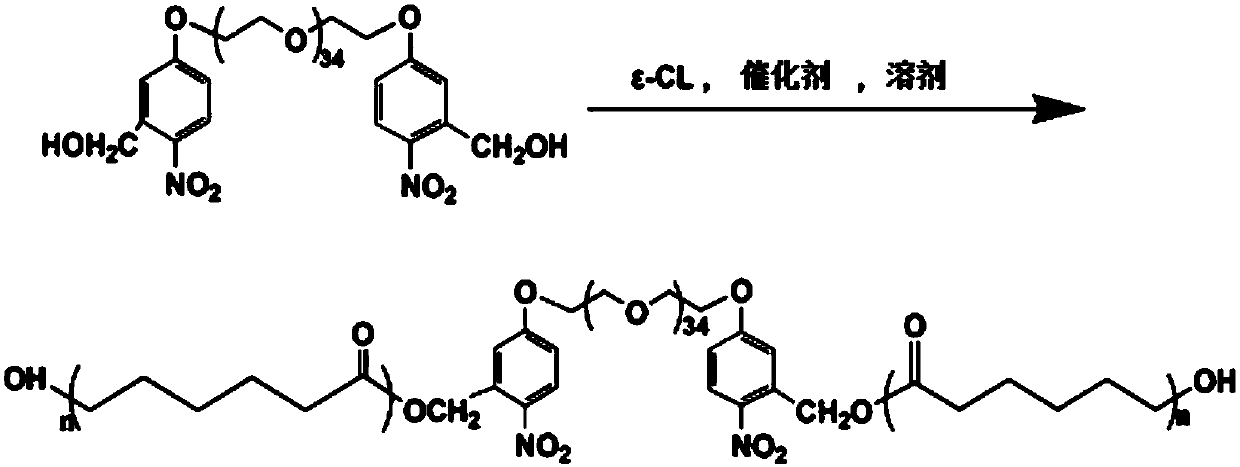Light and temperature dual responsive copolymer, its synthesis method and hydrogel system
A dual-response, synthetic method technology, applied in prosthetics, medical science, etc., can solve the problems of limited application research in the biomedical field, and achieve good biocompatibility and biodegradability
- Summary
- Abstract
- Description
- Claims
- Application Information
AI Technical Summary
Problems solved by technology
Method used
Image
Examples
Embodiment 1
[0035] A light- and temperature-responsive copolymer, which is a polyethylene glycol (PEG) composed of a photosensitive o-nitrobenzyl group (ONB) connected to a hydrophobic segment polycaprolactone (PCL) and a hydrophilic segment polyethylene glycol (PEG). Lactone-polyethylene glycol-polycaprolactone triblock copolymer (PCL-ONB-PEG-ONB-PCL), wherein the number-average molecular weight ratio of the PCL / PEG segment in the copolymer is 0.9.
[0036] The number average molecular weight of the hydrophilic segment PEG in the copolymer of this embodiment is 1000.
[0037] In this embodiment, the specific synthesis steps of PCL-ONB-PEG-ONB-PCL triblock copolymer are as follows:
[0038] S1: Preparation of di-o-nitrobenzyl polyethylene glycol macroinitiator
[0039] S11: Weigh the following materials: 5-hydroxy-2-nitrobenzyl alcohol, sodium hydride, anhydrous tetrahydrofuran, tosylated polyethylene glycol, the 5-hydroxy-2-nitrobenzyl alcohol and sodium hydride The molar ratio of 5-hy...
Embodiment 2
[0051] A light- and temperature-responsive copolymer, which is a polyethylene glycol (PEG) composed of a photosensitive o-nitrobenzyl group (ONB) connected to a hydrophobic segment polycaprolactone (PCL) and a hydrophilic segment polyethylene glycol (PEG). Lactone-polyethylene glycol-polycaprolactone triblock copolymer (PCL-ONB-PEG-ONB-PCL), wherein the number-average molecular weight ratio of the PCL / PEG segment in the copolymer is 0.8.
[0052] The number average molecular weight of the hydrophilic segment PEG in the copolymer of this embodiment is 1000.
[0053] In this embodiment, the specific synthesis steps of PCL-ONB-PEG-ONB-PCL triblock copolymer are as follows:
[0054] S1: Preparation of di-o-nitrobenzyl polyethylene glycol macroinitiator
[0055] S11: Weigh the following materials: 5-hydroxy-2-nitrobenzyl alcohol, sodium hydride, anhydrous tetrahydrofuran, tosylated polyethylene glycol, the 5-hydroxy-2-nitrobenzyl alcohol and sodium hydride The molar ratio of 5-hy...
Embodiment 3
[0067] A light- and temperature-responsive copolymer, which is a polyethylene glycol (PEG) composed of a photosensitive o-nitrobenzyl group (ONB) connected to a hydrophobic segment polycaprolactone (PCL) and a hydrophilic segment polyethylene glycol (PEG). Lactone-polyethylene glycol-polycaprolactone triblock copolymer (PCL-ONB-PEG-ONB-PCL), wherein the number-average molecular weight ratio of the PCL / PEG segment in the copolymer is 1.0.
[0068] The number average molecular weight of the hydrophilic segment PEG in the copolymer of this embodiment is 1000.
[0069] In this embodiment, the specific synthesis steps of PCL-ONB-PEG-ONB-PCL triblock copolymer are as follows:
[0070] S1: Preparation of di-o-nitrobenzyl polyethylene glycol macroinitiator
[0071] S11: Weigh the following materials: 5-hydroxy-2-nitrobenzyl alcohol, sodium hydride, anhydrous tetrahydrofuran, tosylated polyethylene glycol, the 5-hydroxy-2-nitrobenzyl alcohol and sodium hydride The molar ratio of 5-hy...
PUM
| Property | Measurement | Unit |
|---|---|---|
| phase transition temperature | aaaaa | aaaaa |
Abstract
Description
Claims
Application Information
 Login to View More
Login to View More - R&D
- Intellectual Property
- Life Sciences
- Materials
- Tech Scout
- Unparalleled Data Quality
- Higher Quality Content
- 60% Fewer Hallucinations
Browse by: Latest US Patents, China's latest patents, Technical Efficacy Thesaurus, Application Domain, Technology Topic, Popular Technical Reports.
© 2025 PatSnap. All rights reserved.Legal|Privacy policy|Modern Slavery Act Transparency Statement|Sitemap|About US| Contact US: help@patsnap.com



